Travel India: A Love Triangle – India’s Golden Triangle in 7 Days
Travel India: A Love Triangle – India’s Golden Triangle in 7 Days
By Cherie Thiessen, Photos by David Dossor
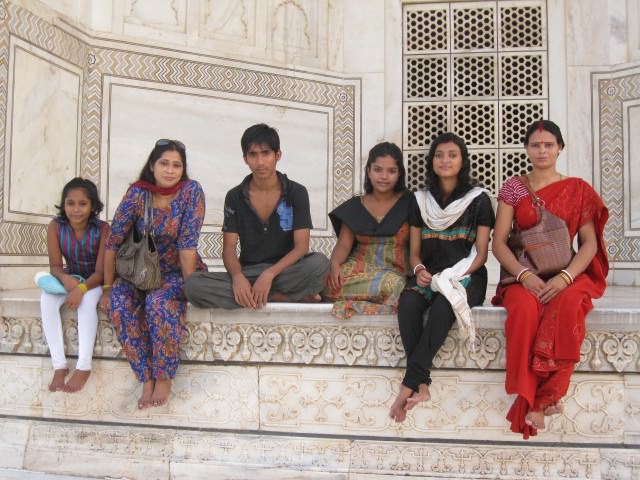
Locals at Taj Mahal in India – Photo by David Dossor
When you visit India, whether for a day or a year, the first thing you have to do is shake the moths out of the way you think. Everything needs to be re-defined, and isn’t that actually a good thing? Sort of like cleaning out the basement? So when our small bus is rolling down the freeway from Delhi to Agra, on the first leg of what’s commonly called “The Golden Triangle”, we quickly re-define ‘freeway’. Freeway: a road where you can travel freely in any direction and fit into any space that’s free in that particular second.
The shriek goes up from the bus’s 22 passengers, definitely louder in the front half where occupants have a clearer view of the much, much larger bus that is about to hit us.
We swerve and it blares past. Now the shrieks are replaced with nervous laughter and the inevitable comments: “It’s just like that scene in the Best Exotic Marigold Hotel.” Bottled water is passed around, and the retired pharmacist, who was so grateful to us when we swapped our front seats for his, half way back in the bus, swivels his head around to eye us suspiciously.
It’s only 240 kilometers from Delhi to Agra, but in India you also need to re-define time and distance; the two are not related. The journey can take 4 hours or 4 days, depending on whether there are any festivals, whether there are cows lying on the road, whether the elephants will move over, and whether the accidents have been cleaned up yet. We make good time getting there in 6 hours, on this our third day, and are so enthralled with the action out the windows that we don’t really notice time passing, only how we begin to suffer from whiplash by the end of the day: not the driver – he’s good, but rather from our heads swiveling back and forth to catch the banana vendors on one side of the bus, the three storey Hindu statues in front of us, and the monkeys starting to cross the road on the other. Look how the baby is lying on its mother’s back!
Lured by impossibly cheap prices, we signed up for this “Golden Triangle” tour through Friendly Planet Travel and left New York 3 days ago. Covering return air fare from the Big Apple on Air India, 6 nights of hotels, entrance to all attractions, all breakfasts, one dinner, bus travel while in India, a local guide, two drivers, tips, and pickup and drop off at the airport, the cost was $1600 each. It seemed ridiculously cheap and our travelling companions obviously felt the same way; they came from all over. We were the only Canadians, but also travelling from a distance were people from San Francisco, Florida, Columbia, and Puerto Rico. My partner and I had never taken a tour before, preferring to do our own thing, but on a first visit to India it seemed to be a good idea to be under someone’s wing.
We nudge each other. “Is this really real?” I ask David as I do on almost every trip, and he replies, as he does on almost every trip. “If it all goes downhill from here, I’ve had a terrific time.”
Me too. Our travelling companions are all interesting and no one has yet held us up. Our guide, Vishal, is entertaining, hard working, humorous, and knowledgeable. The tour of some of Delhi’s delights yesterday was great, even in the rain on the fringes of the monsoon season.
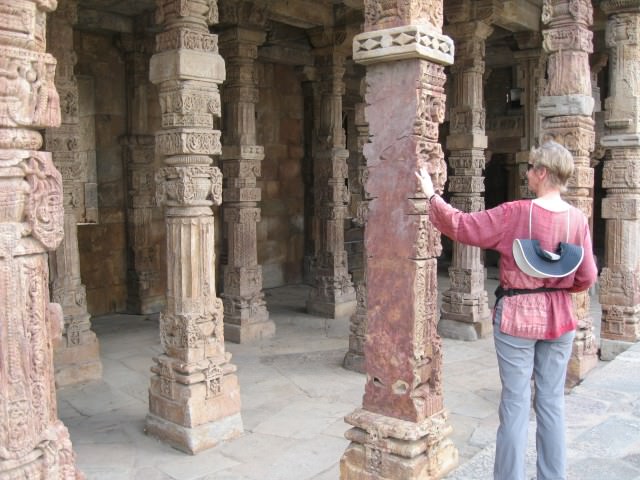
Cherie Thiessen at Qutab Minar in India – Photo by David Dossor
A visit to the Shri Lakshmi Narayan (Birla) temple in the morning, built to honour the Hindu goddess of wealth and her consort, Vishnu and inaugurated by Mahatma Gandhi, was fascinating. Flowering over 7.5 acres, it’s one of the major attractions of Delhi. Then there was a stop at a UNESCO world heritage site, Qutab Minar, a 900-year-old, 238’ minaret made of red sandstone that looks as if it were erected this morning. Built immediately after the defeat of India’s last Hindu kingdom, it’s 376 steps to the top but we can’t venture up. Vishal tells us that it was closed to the public when a group of schoolgirls fell down the stairs to their deaths. The carvings in the minaret’s angular and rounded flutings are Lilliputian wonders. An iron column in the center of the site is unique in that in the 1400 years it has been standing here, it has never rusted. Can’t they do that for humans?
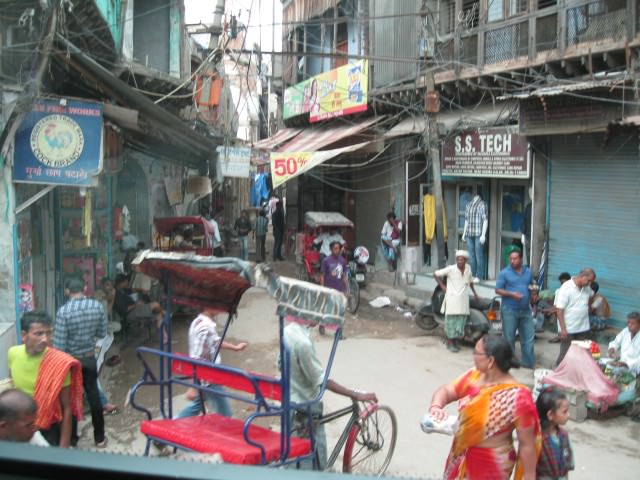
Old Delhi, India – Photo by David Dossor
Back to the streets of Old Delhi, with its iconic coils of electric cables hanging in near chaos over the street scenes. I imagine these gigantic hairballs getting larger and heavier as each new do-it-yourself electrician adds his own lock to the creation. We climb aboard a bicycle rickshaw for a madcap tumble under them, through a slice of the old town. The streets are so narrow that if I weighed another 5 lbs they’d have to shave off the corners of the buildings, and yet – in these narrow streets are locals lounge smoking and drinking tea, vendors laying out material on which to display their goods, and mothers feeding babies. Our senses go into overload: the smells of incense and urine, the colors of saffron, emerald and a century of dust, the sheen of the rich fabrics on women who manage to look elegant even while throwing their trash in front of the rickshaws.
When driving next to Raighat, a manicured memorial to Mahatma Gandhi, we spy a naked child, perhaps about 2, standing in front of one of the many tents that sprawl on the side of Delhi’s busy roads. “Transient workers live there,” says Vishal. There’s no one near the toddler, who stands entranced watching the traffic swaying and honking past, and once again we re-define our notions of child abuse. Report the parents to the police for neglecting their infant? But what would these itinerant parents say of our culture of play dates and constant surveillance?
The afternoon melts into a hazy heat as the monsoon rolls up its magic carpet and leaves for another part of the world, and eventually we roll back to our 5-star hotel for an excellent meal, and another night. It’s soon time to go on to the second love in our golden triangle, the Taj Mahal. Built between 1632 and 1658, it’s all about the façade, that, and mathematics, Vishal informs us. The gleaming white marble mausoleum was built to impress upon first glimpse. It’s about love too, of course. Inside was only for the body of Emperor Shah Jahan’s wife, Mumtaz Mahal, the woman he loved to death; she died giving birth to their 14thchild.
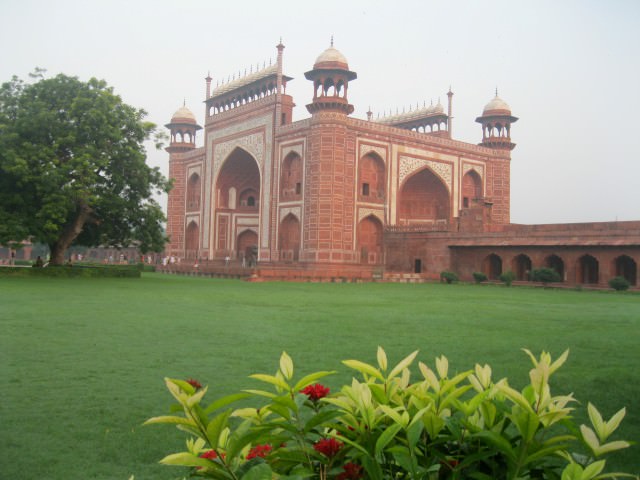
And This Is Just The Gate – Photo by David Dossor
With a coral sunrise cloaking our shoulders, we wait for entrance into this mystical siren, while locals walk their camels beside us, and then we move through the entrance and I get my first glance. “It’s incredible, but it’s not white,” I whisper to David, almost swooning at the beauty I see in front of me. “That’s because it’s not the Taj Mahal”, he whispers back. “Get a grip, You’re embarrassing me.”
And yet what I’m looking at is stunningly beautiful: the main entrance gate, just the entrance gate!
Once through it, David nudges me as we stand entranced. “Now you can swoon.” the Taj Mahal radiates the same vermillion as the sky, the marble seeming to absorb the sunrise and pulse with it. Rising from immaculate, beautiful gardens, with green parakeets flitting in and out of the lofty edifice and hornbills calling in the trees, it alone was worth the 16-hour plane trip. In perfect balance, two seemingly identical Muslim temples frame this new 7th wonder of the world. Only one is a temple, however. The other was built simply to get the symmetry right; this is where the mathematics comes into it. Behind the monument to love, the Yamuna River and the park on its other shore make the perfect backdrop.
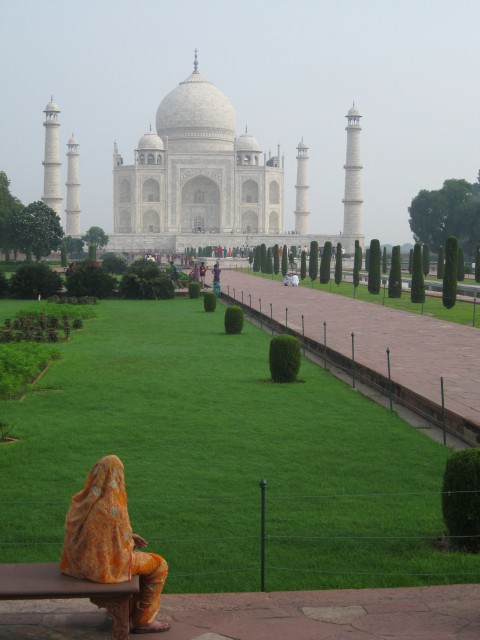
Taj Mahal – Photo by David Dossor
An hour later, as we leave, dripping sweat and reverence, and as the Taj changes hue to radiate a pristine white brilliance that would strike envy in every dentist’s heart, David begins his now daily incantation: “If I die tomorrow…”
And yet still ahead of us on the old silk route, one of the oldest roads in the world, are so many more wonders in the triangle. Akbar’s elaborate city of Fatehpur Sikri, abandoned in 1585, 15 years after its construction; the 1000-year old Amber Fort which we’ll approach on elephants; the Pink City of Jaipur, Rajasthan’s vibrant capital, rightly often called the Paris of India, and more ancient and intricate monuments to emperors, to Hindu gods, and to Muslim’s Allah. We’ll experience way more sights, sounds, smells, and tastes than one would ever think possible to cram into a mere 7 days.
Another definition hits the dirt, as we search for new way to define time. A week in India is NOT a week.
India Fun Facts:
Did you know….
- That India has the second largest Muslim population in the world?
- That Delhi has really cleaned up its act? The ubiquitous little Tuk tuks (3-wheel auto rickshaws) you see everywhere have recently been required to convert to compressed natural gas, making a huge difference in air quality. In addition, motorized vehicles cannot approach the Taj Mahal. Only non-polluting electric transport is allowed. As well, all industry within kilometers of the Taj Mahal has been shut down.
- That India doesn’t import anything from China? According to our guide, it imports very little from any country.
- That silk is the second strongest material on the planet? (We’re told this at a silk carpet company where we drink green tea served with saffron and honey and munch on samosas as we’re shown luminous silk creations in the air-conditioned showroom.)
If You Go:
- Friendly Planet Travel (gets 5-stars from us)
- Air India
- General India Tourism Site
Bio:
Cherie Thiessen is a long time travel writer and travel writing instructor. A member of both the B.C. Travel Writers’ Association and the Travel Media Association of Canada, she writes local, national and international stories from her Gulf Island home.
All photo credits: David Dossor

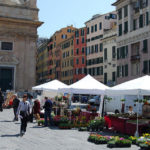

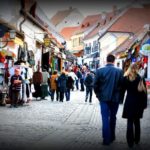






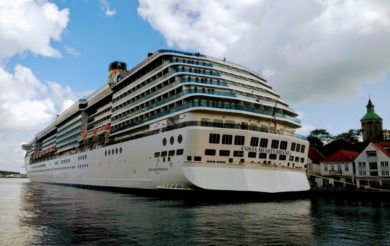
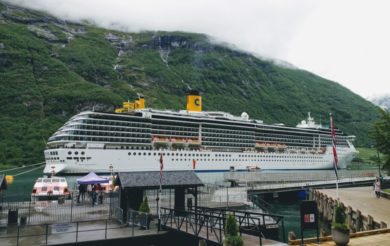
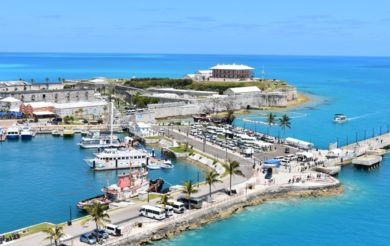

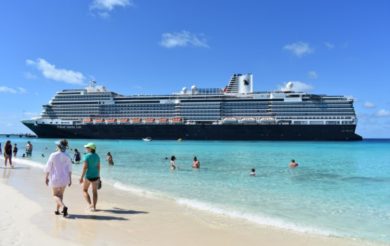






One Response to Travel India: A Love Triangle – India’s Golden Triangle in 7 Days